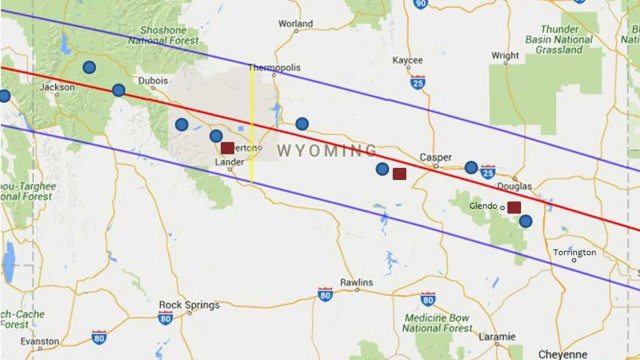
The University of Wyoming will help to provide a front-row seat to the next total solar eclipse to cross the United States.
The historic phenomenon is scheduled to occur August 21, 2017, and Wyoming will provide some of the best viewing in the county.
“It’s a spectacular thing to see. It’s predictable, but it’s a once-in-a-lifetime opportunity,” says Michael Pierce, a UW associate professor in the Department of Physics and Astronomy. “It’s awe-inspiring. You see a part of the sun that is never seen. This will be something that people will tell their grandchildren about.”
Pierce is the Wyoming state coordinator for NASA’s Citizen CATE (Continental-America Telescopic Eclipse) Experiment. Using 61 telescope stations across the country, including nine in Wyoming spaced approximately 50 miles apart, the project’s goal is to create a continuous 90-minute movie of the solar corona during the total eclipse. Researchers and scientists hope to gain a better understanding of the sun’s inner corona.
A total solar eclipse is when the moon’s shadow touches the Earth and blankets portions of it in total darkness for a few moments. In essence, the sun, moon and Earth align. A person in the dark part of that shadow, known as the umbra, will see a total eclipse. A person in the light part, called the penumbra, will see a partial eclipse.
Pierce says scientists want to study the behavior of the hot gases in the sun’s inner solar corona.
“The temperature changes dramatically, from 6,000 degrees at the surface of the sun. Then, the glow (resembles a diamond) you see around the sun during the eclipse goes to 1 million degrees,” Pierce explains. “This is a rapid temperature change. The inner part of the corona has complex filaments that look like fingers, and these trace the sun’s magnetic field.”
New scientific results about the dynamics of the magnetic fields and plasmas in this part of the solar corona will be derived from the data collected at the 61 telescope sites nationwide.
Lining up the Telescopes
Nine portable refracting telescopes will be stationed in Wyoming at the following locations:
Wilson, just west of Jackson; Elk Ridge, Dubois High School, Lakeside Boulevard near the Pilot Butte Reservoir, located between Dubois and Riverton; the city park in Riverton; Hell’s Half Acre, a large scarp located approximately 40 minutes west of Casper; Izaak Walton Park in Casper; Bartling Park in Douglas; and Guernsey Elementary School. High school science teachers and students will man the telescopes and, using a laptop hooked to each, video record the total eclipse at each point, Pierce says.
“The inner part of the corona can only be seen during a solar eclipse. We’ll end up with a nice video that shows how the corona changes in time,” Pierce says. “In 1979, the last total eclipse in the United States, we did not have these technological capabilities. Before the Internet and digital cameras, we had a few pictures here and there. This is the first time we can do this experiment.”
The last total solar eclipse to cross the continental United States occurred Feb. 26, 1979 — more than 37 years ago. This next one will start in Oregon and move in a southeasterly direction all the way to South Carolina, Pierce says.
The southern part of Grand Teton National Park will be one of the best places in the entire country to view the eclipse, according to the website Eclipse2017.org. On the centerline, the park will experience 2:20 of totality at about 11:35 a.m.
The shadow will then cross Pavillion (at 11:38 a.m.), and Shoshoni and Riverton (at 11:39 a.m.) for about 2:23 before landing squarely on the city of Casper. The centerline will pass right over the intersection of Highway 220 and South Poplar Street in Casper at 11:42 a.m., and provides viewers there with 2:26 in totality.
Douglas, Glendo, Thermopolis, Lusk and Torrington are other larger Wyoming towns that will experience a total eclipse. For those who live in or will be visiting Wheatland at that time, they will be right on the southern edge of the eclipse’s path and, so, the eclipse will only last a few seconds. To experience the full length of totality, people there will need to move north.
During portions of the eclipse where the sun is only partially covered and visible, safety glasses are advised. When it gets fully covered, meaning the moon is in front of and blocking out the sun, it will be safe to view the solar eclipse with the naked eye, Pierce says.
In addition to the manned portable telescope stations, UW may set up — along the path of the eclipse — information tents with additional information about the eclipse for visitors, Pierce says.
Logan Jensen, a UW junior from Greybull majoring in astronomy, is currently being trained in solar physics as part of a summer research program at the National Solar Observatory in Tucson, Ariz. Jensen is assisting Pierce with the Wyoming portion of the Citizen CATE project.
“When the eclipse is over, all of the schools participating will get to keep the telescopes and video cameras,” Pierce says. “The hope is the 60 groups across the country will be kind of networked together with contact information and be well-trained in the use of the telescopes. People in the project are currently planning educational activities after the eclipse aimed at sustaining student interest in astronomy.”
And, if you were wondering, the next total solar eclipse over the continental U.S. is scheduled to occur April 8, 2024, according to an article in Astronomy Magazine. For facts you should know about the Aug. 21 solar eclipse, go


